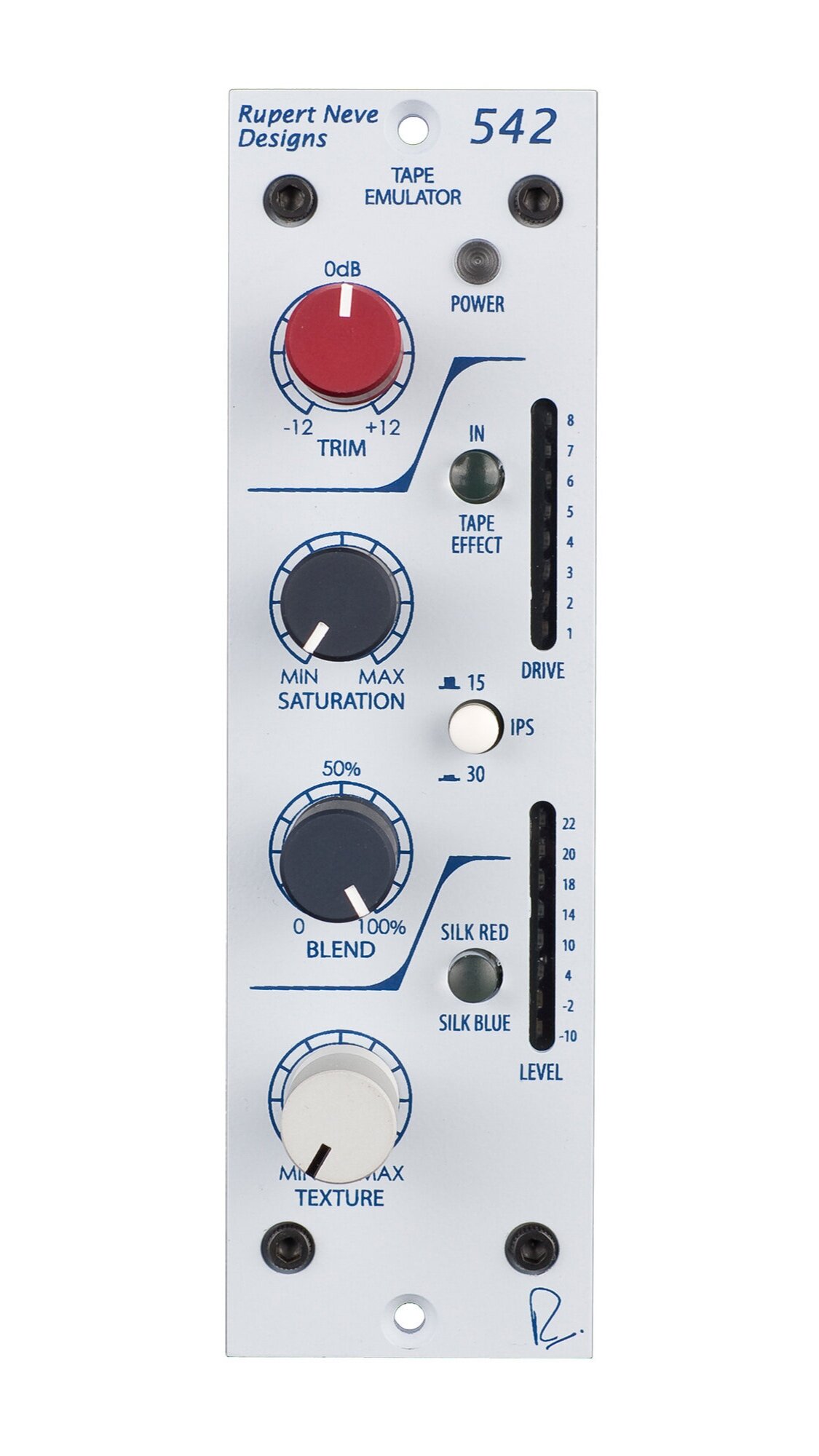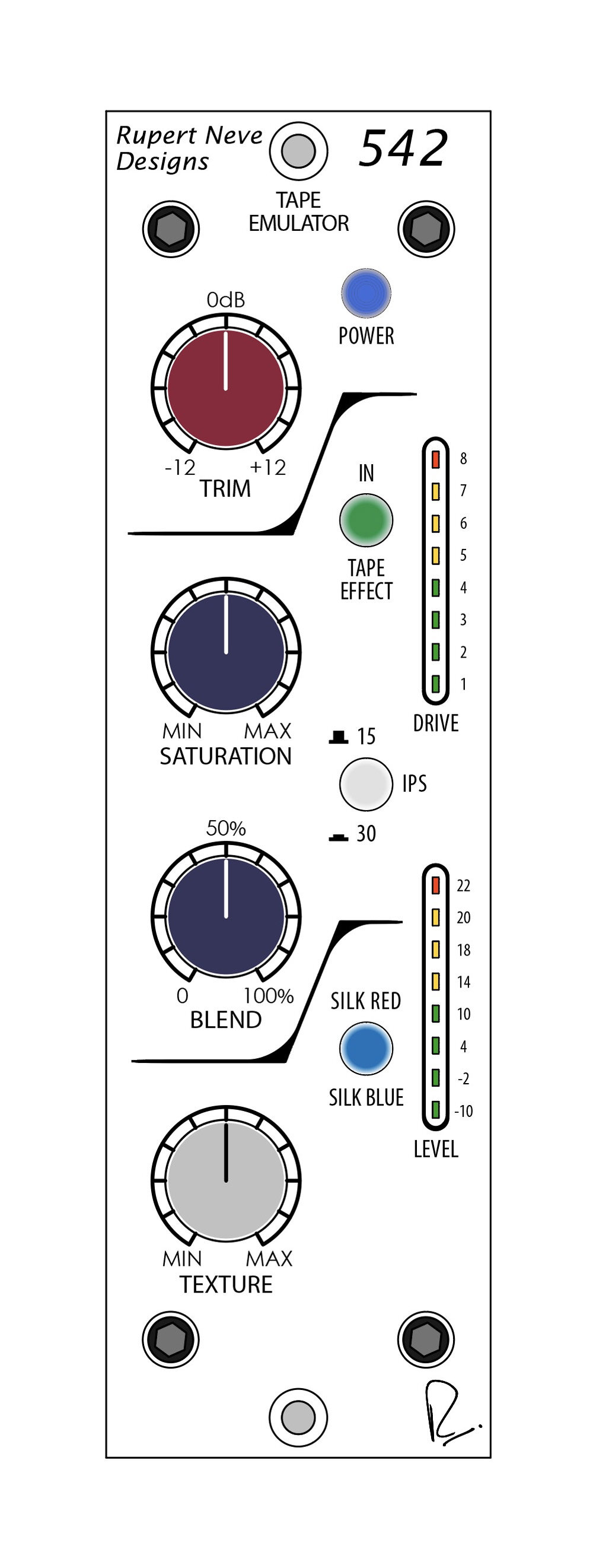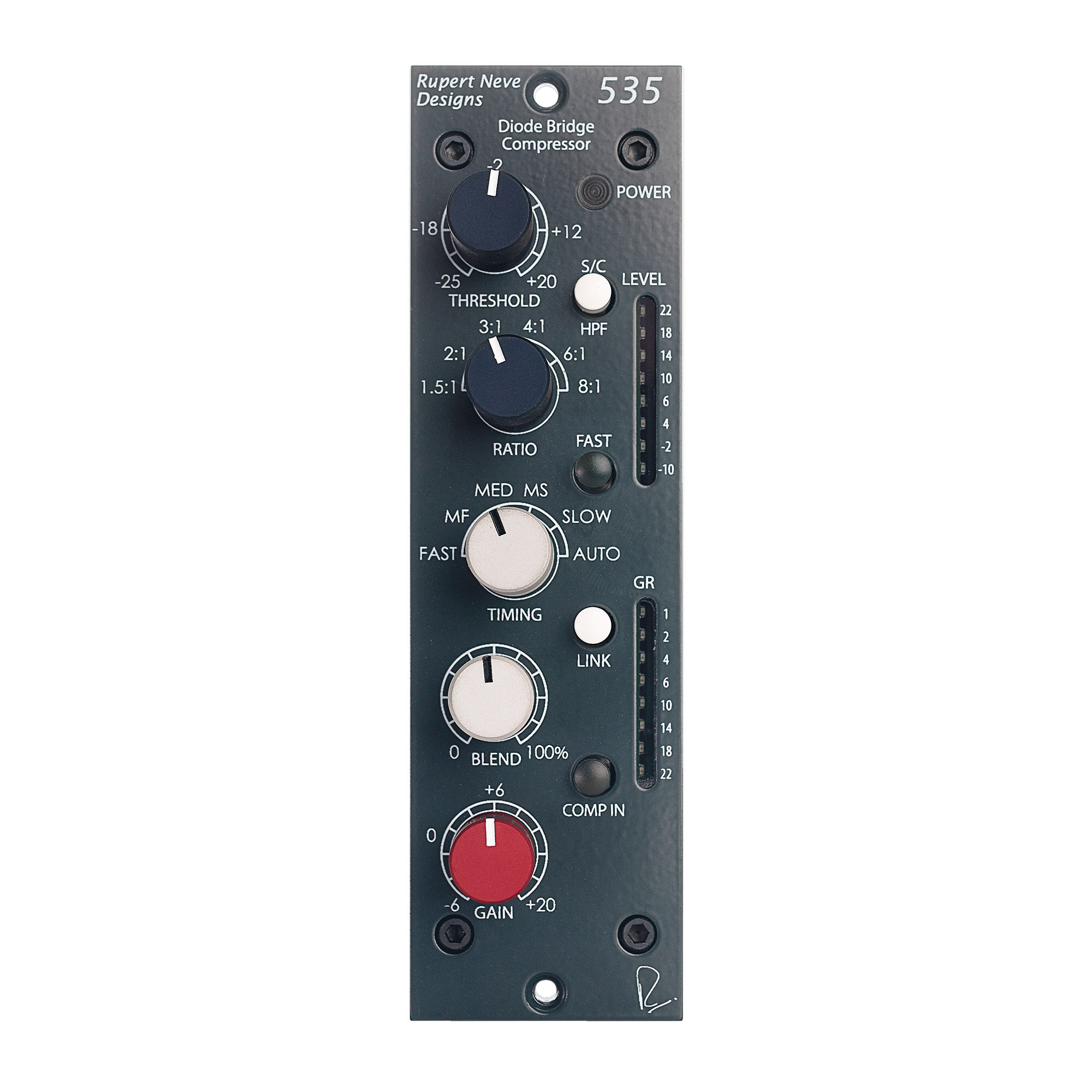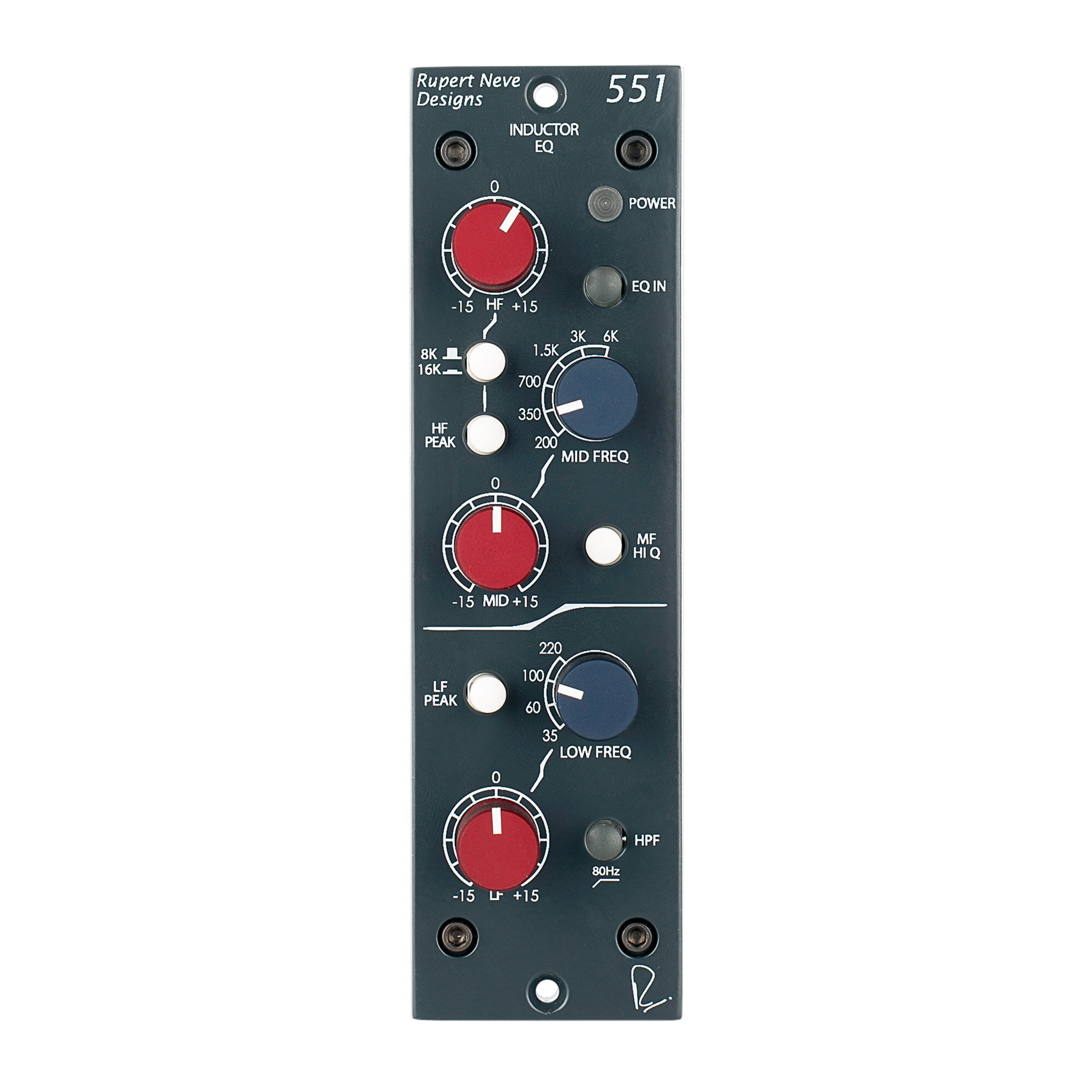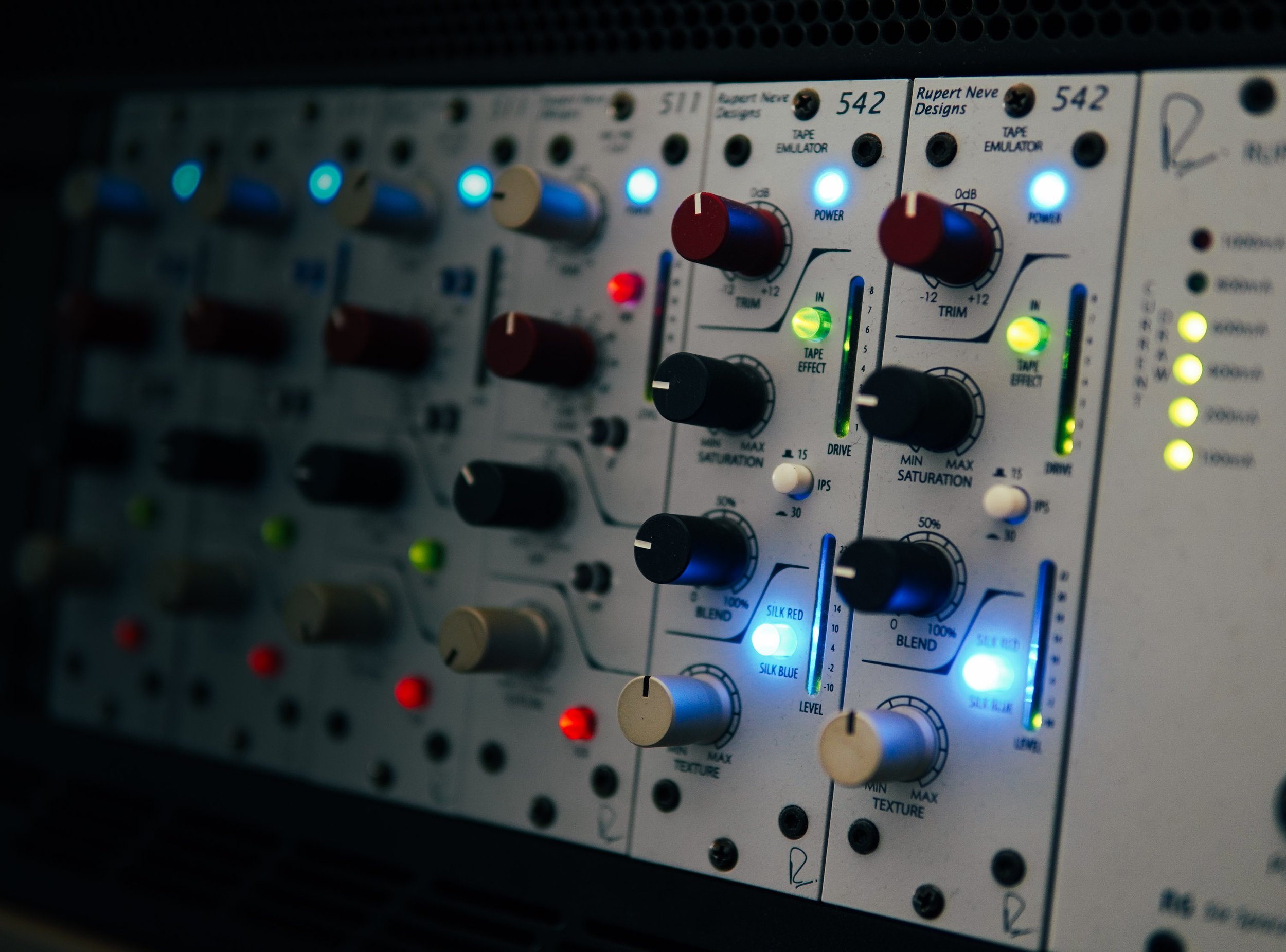
542
500 Series Tape Emulator
OVERVIEW / MEDIA / FEATURES / REVIEWS / SPECS & RESOURCESThe ultimate “color box”.
The 542 delivers a wide variety of elusive analog tones by incorporating a carefully crafted tape emulation circuit, complete with a soft-clipper that can tame the harshest sources, our unique Silk circuit with variable Texture control, and a Blend control to finalize exacting amounts of saturation.
“Absolutely gorgeous...currently reprinting the entire album mixes through the 542.”
Transformers Imitating Tape
Our analog ‘tape effect’ emulation circuit drives a custom interstage transformer that mimics a “record head”, which is coupled to a ‘replay’ amplifier with the appropriate EQ curve applied. Harmonic saturation increases as more gain is applied to the “record head”, and a soft clip circuit engages at higher levels, gently taming peak transients. The sound can be further modified with selectable 15 / 30 IPS modes and a pre/post-tape emulation blend control.
What is Silk?
Our exclusive Silk circuitry provides additional control over harmonic density and tonality. The Silk Red mode accentuates transformer saturation in the high and high-mid frequencies to heighten the frequency range associated with Rupert’s vintage equipment, while Silk Blue accentuates saturation of the lows and low-mids to add thickness and weight to any source. Unlike traditional EQ, these Silk & Texture controls saturate the custom output transformer of the 542, adding rich, musical harmonics according to the amount of Texture applied.
Drive the 542 hard, choose your Silk flavor, and crank the Texture knob for a rich, saturated, vintage vibe – or disengage Silk entirely for a more purist, hi-fi tape effect. The choice is yours.

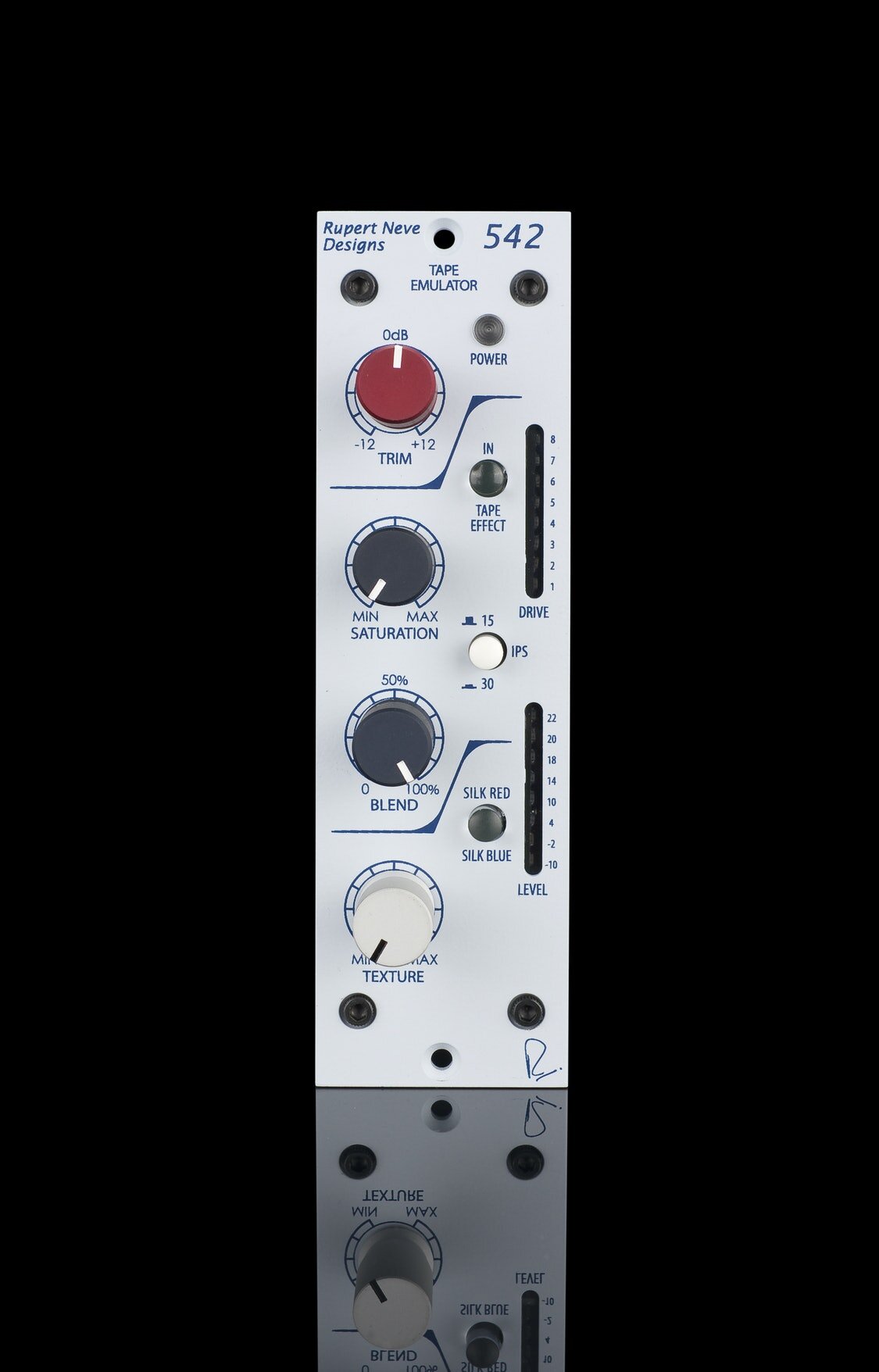
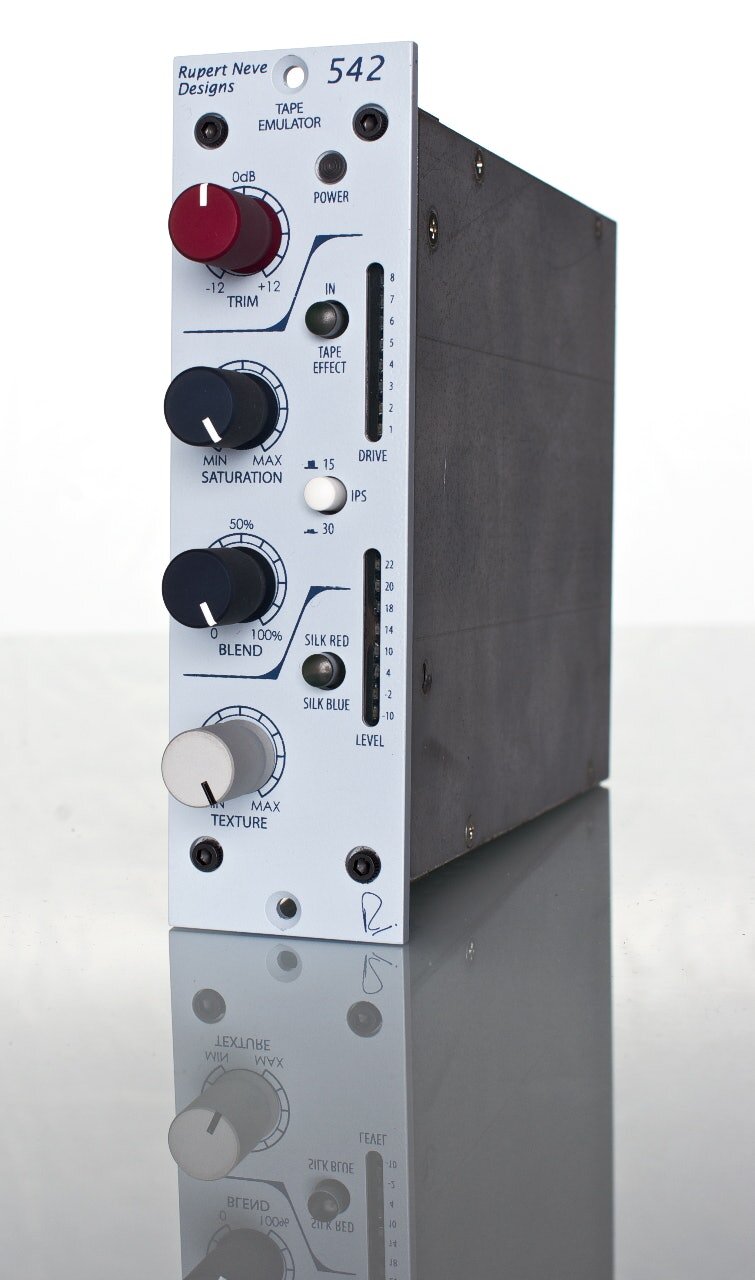
TAPE EFFECT IN
Illuminated push-button switch that engages our ‘tape’ emulation circuit, which includes controls for saturation, blend and 15 / 30 IPS filter curves.
TRIM
Provides +/– 12dB adjustment of level on incoming signal levels, prior to the tape circuit.
SATURATION
Continuously variable control of the level being sent to the ‘tape effect’ circuit. Increasing Saturation levels drives the ‘record’ gain while simultaneously reducing the ‘replay’ gain so the overall output signal level remains consistent. The output signal level will decrease slightly as the MAX setting is approached due to the extreme saturation and soft clipping.
Saturation also controls a low frequency compensation circuit that boosts low frequencies a little more at lower saturation levels and tapers off at higher levels. This function can be useful searching for a balance between a cleaner, boosted low end (low saturation) and a denser, more saturated low end (high saturation).
15/30 IPS
Push-button switch that toggles between 2 different frequency responses commonly found at 15 or 30 IPS tape machine speeds. The 15 IPS mode has a significant “head bump” in the low frequencies centered around 60Hz and a more pronounced roll off in the high frequencies. The 30 IPS mode is generally a flatter response altogether with a “head bump” around 120Hz.
BLEND
Continuously variable control of the mix of pre and post tape effect signals. This allows for precise control over the amount of saturation, tone and soft clipping produced. As the signal gets more saturated, reducing the blend can be an effective way to impart the sound of ‘tape’ while maintaining detail and transparency. NOTE: The blend control does not affect the amount of Silk Texture applied.
SOFT CLIP
The soft clip circuit engages when the drive meter hits 5 (first yellow LED) and becomes more apparent at higher levels. The soft clip can be used to tame sharp transient material like drums and can be further controlled by using the blend control.
SILK / TEXTURE
Illuminated push-button switch that toggles through the three available SILK modes: OFF, RED, and BLUE. RED enhances harmonic content in high mid and high frequencies. BLUE enhances harmonic content in low and low mid frequencies.
LEVEL / DRIVE METERS
Two eight segment LED meters are included for indicating output level and drive amount. The level meter displays the output level of the 542 before the Silk circuit, and the drive meter displays the level sent to the “record head” when the tape effect is engaged. The soft clip circuit is present at drive levels above 5.
REVIEWS
“What the 542 does is bring the sound of analogue tape to your system without the need to keep an enormous tape machine properly serviced, or the costs associated with reels of tape. In a world of DAW recordings, super clean mic preamps and convertors, the ability to add back even just a little analogue saturation, fully under your own control, is enlightening.”
“This is a very clever product that introduces some very interesting and useful tonal shaping effects…a very useful option to have in the rack.”
Hugh Robjohns / Sound On Sound
“The new Portico 542 tape emulator by Rupert Neve is absolutely gorgeous…currently reprinting the entire album mixes through the 542.”
Greg Wells
Adele, Katy Perry, Taylor Swift, John Legend
“The 542 completely delivers. With a bit of tweaking you can really capture that ‘tape’ sound. Beats all the plugins, as far as I’m concerned – in fact, it’s on a totally different level. Makes me feel like I’m back at Excello working on 2-inch with Bob Weston!”
Jason Rabe / The VLA
“This pair will live forever on my 2 bus…turn if off while playing your mix back and that is when you will realize that these things are staying put.”
“There’s no tape plug-in that quite does this. Not to my ears. And I have them all.”
“Can be subtle or sizzle but you definitely notice the difference when you hit the bypass. Everything sounds better through these. I bought a pair.”
“I love it. I want to remix everything I’ve done.”
Customer Reviews via vintageking.com
“I’ve had the 542 for 3 weeks now and I love it. I’ve recorded electric and acoustic guitars, bass guitar, vocals, synth and drum overheads. Everything I track through it needs less processing come mix time, and combines with other instruments better.”
“Words cannot express what the Neve 542 will do to your recordings. It will thicken and smooth out the mix…this unit will work wonders for your tracks. True analog, vintage tone.”
“In my constant pursuit of tone I found this, I bought two for across my mix bus and it was there.”
“The moment I ran my mix through these instead of a [plug-in] Studer, everything changed. My mix went from the signature ‘digital / analogue hybrid’ sound to pure analog without even the slightest hint of digital influence. I was back on a large format console with 2” tape…there isn’t a studio I know of that couldn’t benefit from these. Enjoy!”
“You may be skeptical looking at this unit, but it really does what everyone says. When it's in your signal chain, everything sounds richer, warmer, and bigger. It's awesome.”
“Love at first listen…I don’t think I could live without my pair after using them for the last few sessions!”
“It’s the closest I’ve ever found to a magic box.”
Customer Reviews via sweetwater.com

SPECIFICATIONS & DOWNLOADS
TAPE EFFECT DISENGAGED:
TOTAL HARMONIC DISTORTION AND NOISE (NO SILK)
@ 1 kHz, +20 dBu output level: Better than 0.0025%
@ 20 Hz, +20 dBu output level: 0.07% Typical (2nd and 3rd order harmonics)
NOISE
Measured at Main Output, un-weighted, 20 Hz - 22 kHz, Input Terminated 40 Ohm. Noise specifications may vary depending on which 500 series chassis is being used, and / or interference from stray magnetic fields.
Unity Gain: Better than -100 dBV
FREQUENCY RESPONSE (Main Output, no load)
5 Hz to 60 kHz: +/- 0.25 dB
120 kHz: -2 dB
TAPE EFFECT ENGAGED:
TOTAL HARMONIC DISTORTION AND NOISE (NO SILK)
15 IPS, Input @ 0 dB, Saturation @ MIN:
0.4% @ 3kHz typical
1% @ 175 Hz typical
15 IPS, Input @ 0 dB, Saturation @ MAX:
1% @ 6kHz typical
0.3% @ 1 kHz to 3% @ 50 Hz typical
30 IPS, Input @ 0 dB, Saturation @ MIN:
1 % @ 1 kHz typical
0.6% @ 400 Hz to 5% @ 20 Hz typical
30 IPS, Input @ 0 dB, Saturation @ MAX:
1.5% @ 20 kHz to 0.4% @ 1 kHz typical
2% @ 50 Hz typical
FREQUENCY RESPONSE
15 IPS, Input @ 0 dB, Saturation @ MIN:
-3 dBu @ 28 kHz
0 dBu @ 10 Hz
+5 dBu Peak @ 60 Hz
15 IPS, Input @ 0 dB, Saturation @ MAX:
-3 dBu @ 20 kHz
-3 dBu @ 12.5 Hz
+2.4 dBu Peak @ 60 Hz
30 IPS, Input @ 0 dB, Saturation @ MIN:
-3 dBu @ 120 kHz
-3 dBu @ 10 Hz
+3.15 dBu Peak @ 125 Hz
30 IPS, Input @ 0 dB, Saturation @ MAX:
-3 dBu @ 100 kHz
-3 dBu @ 12.5 Hz
+1.3 dBu Peak @ 110 Hz
NOISE (Measured at main output, un-weighted, 20 Hz - 22 kHz, 40 ohm balanced source)
Saturation @ MIN: Better than -100 dBu
Saturation @ MAX: Better than -100 dBu
Power Consumption (+/- 16 VDC): 110-125 mA
UNIT DIMENSIONS
1x 500 Series Module: 1.5” W x 5.9” D x 5.25” H
(3.8 cm W x 15 cm D x 13.3 cm H)
UNIT WEIGHT
1.5 lbs. (0.7 kg)
SHIPPING DIMENSIONS
10” W x 8” D x 3” H
(25.4 cm W x 20.3 cm D x 7.6 cm H)
SHIPPING WEIGHT
3 lbs. (1.4 kg)
FREQUENTLY ASKED QUESTIONS
Yes, all of our modules are designed within the 500 Series specification and we are not aware of any instances where they have not worked as intended.
No. The 542 uses two “tape head” circuits across a magnetic gap to mimic the sonic attributes of tape.
Yes – a pair of 542s can be VERY effective on stereo mixes. Just make sure to set the controls identically on both units for proper stereo imaging.
However, it’s also worth noting that the additive effect of the saturation across each individual track in a mix may be more desirable (or more interesting) than merely putting two 542s across the mix buss. We encourage you to experiment!
We utilize an electrogalvanized chassis to shield the internal circuitry from interference. With this process, it isn’t possible to “finish” the chassis metal (i.e. polishing or anodizing) so the machining marks from forming the metal will be visible. In normal operation inside a 500 series rack, this metal will never be visible.
We use standard 4-40 ¼" screws to secure our 500 series rack modules. Each of our modules and our R6 and R10 racks include these screws. Please contact our service department if you have questions or need additional screws.


